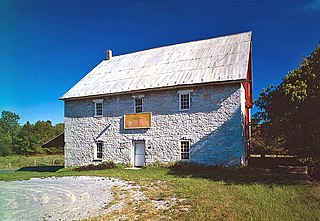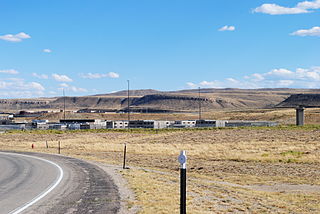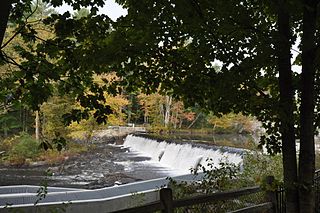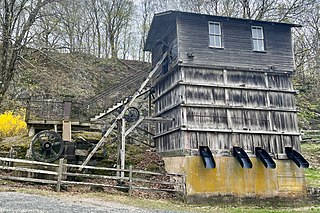
The Wilcox, Crittenden Mill, also known as Wilcox, Crittenden Mill Historic District, is a 17-acre (6.9 ha) property in Middletown, Connecticut that was listed on the National Register of Historic Places in 1986. It was the location of the Wilcox, Crittenden company, a marine hardware firm. The historic district listing included four contributing buildings and three other contributing sites.

College Hill is a neighborhood in the west central section of the United States city of Greensboro, North Carolina. College Hill was Greensboro's first neighborhood.

The Jackie Robinson House is a historic house at 5224 Tilden Avenue in the Brooklyn borough of New York City. Built c. 1912-1916, it is prominent as the home of baseball great Jackie Robinson from 1947, when he was awarded Rookie of the Year, through 1949, when he was voted Most Valuable Player. It was declared a National Historic Landmark in 1976.

The Stony Brook Reservation Parkways are a group of historic parkways in Boston and Dedham, Massachusetts. They provide access to and within the Stony Brook Reservation, a Massachusetts state park. The roadways and the park are administered by the Massachusetts Department of Conservation and Recreation, a successor to the Metropolitan District Commission, which oversaw their construction. The roads consist of the Dedham, Enneking, and Turtle Pond Parkways and West Boundary Road. Two roads within the park, Smithfield Road and Reservation Road, are listed as non-contributing properties. The park roads were built between 1894 and 1956, and were listed on the National Register of Historic Places in 2006.

Wanakena is a hamlet located on the shore of Cranberry Lake in the town of Fine in St. Lawrence County, New York, United States. Tourism is a major industry in the area; a small year-round population is supplemented by an influx seasonal residents each summer. It is the location of the SUNY-ESF Ranger School.

The Bunker Hill Historic District is the center of the town of Bunker Hill, West Virginia. Today located on the road called US 11, the town was developed along the Martinsburg, West Virginia - Winchester, Virginia road. Bunker Hill served southern Berkeley County with three stores, six mills, and five churches. It was also home to a significant African-American population.

The statue of John Aaron Rawlins, a United States Army general who served during the Civil War and later as Secretary of War, is a focal point of Rawlins Park, a small public park in Washington, D.C.'s Foggy Bottom neighborhood. It was installed in 1874, but relocated several times between 1880 and 1931. The statue was sculpted by French-American artist Joseph A. Bailly, whose best known work is the statue of George Washington in front of Independence Hall in Philadelphia.

Durham Mill and Furnace is a historic grist mill located in Durham Township in Bucks County, Pennsylvania. The mill was built in 1820, on the foundations of Durham Furnace. The furnace was built in 1727 and remained in operation for 70 years.

The Wyoming State Penitentiary is a historic and current prison in Rawlins, Carbon County, Wyoming, which has operated from 1901. It moved within Rawlins to a new location in 1981. In 2018, it is a Wyoming Department of Corrections state maximum-security prison for men.

The Wiswall Falls Mill Site is a historic archaeological industrial site in Durham, New Hampshire. It is located in John Hatch Park, a small public park just south of Wiswall Road on the eastern bank of the Lamprey River. The 3-acre (1.2 ha) site encompasses the remains of a small 19th-century mill complex that was one of Durham's major industrial sites of the 19th century until it burned in 1883. The site, which includes remains of the waterworks and foundations, was listed on the National Register of Historic Places in 1988.

Mitchell-Maskrey Mill is a historic building located in Maquoketa, Iowa, United States. John Goodenow started the first milling operation in the Maquoketa area in 1838. He sold it to Joseph McCloy who established a larger operation along Mill Creek south of town in 1842. Edward Maskry leased this operation in 1865. He purchased this lot from the Methodist Church a few years later, and operated a mill in the old sanctuary. This three story brick structure was built in 1886 around the old frame church. When it was completed the old church building was dismantled. While it has changed owners, the facility has continuously served the same company. Frank Mitchell partnered with Stephen Maskrey in 1912, and the company has been known as Mitchell-Maskrey Co. ever since. This is the only industrial building in Maquoketa's central business district. The building was listed on the National Register of Historic Places in 1991. The mill sustained some damage in a massive fire on January 19, 2008, that destroyed five buildings and severely damaged a sixth immediately to the west.

The Mills Tower Historic District is a nationally recognized historic district located in Iowa Falls, Iowa, United States. It was listed on the National Register of Historic Places in 1990. At the time of its nomination the district consisted of six resources, including two contributing buildings, and four non-contributing buildings. All of the buildings are associated with the Illinois Central Railroad (IC). The Dubuque & Sioux City Railroad, an affiliate of the IC, laid the first rail track to Iowa Falls in 1866. The following year the Iowa Falls & Sioux City Railroad, another IC affiliate, continued construction of the line to the west, and it reached Sioux City by 1870. The Burlington, Cedar Rapids and Northern Railway (BCR&N) by way of its affiliate the Cedar Rapids, Iowa Falls & North Western, entered Iowa Falls in 1880. Two years later it was expanded to the north and intersected with the IC main line, which required a controlled crossing. Little is known about this first crossing and what it contained.

The Downtown Rawlins Historic District comprises the historic center of Rawlins, Wyoming. It comprises the area between Second and Sixth Streets and Front to Buffalo Streets and along 5th Street between West Spruce and West Cedar. The town owes much of its living to the Union Pacific Railway, which took advantage of spring in the Rawlins area to establish services there.

The Rawlins Residential Historic District abuts the north and east sides of the commercial district of Rawlins, Wyoming. United States. The area covers 15 blocks of small houses built between 1880 and 1915 in a variety of styles. The area was part of Union Pacific Railway property that was incorporated into Rawlins. One defining feature of the houses is a consistent use of locally quarried stone in foundations and landscape walls. Apart from the houses, St. Joseph's Catholic Church is also within the district. Styles include Queen Anne, cottage and bungalow style architecture.

Rawlins station is a former train station in Rawlins, Wyoming. It was served by the Union Pacific Railroad from its 1901 construction to 1971, and Amtrak from 1971–1983 and 1991–1997. It was added to the National Register of Historic Places in 1993, as the Union Pacific Railroad Depot.

The Willis House is a historic residence in Encampment, Wyoming, United States, that is listed on the National Register of Historic Places.

St. Thomas the Apostle Church is a Catholic parish in Glen Mills, Delaware County, Pennsylvania, United States. Its historic church, located at 430 Valleybrook Road, was built in 1856.

The M. C. Mulligan & Sons Quarry is a 8.8-acre (3.6 ha) historic district encompassing a former limestone quarry located at 56 Main Street in the town of Clinton in Hunterdon County, New Jersey. It was added to the National Register of Historic Places on August 30, 1994, for its significance in agriculture, commerce, and industry. The listing includes six contributing buildings, two contributing structures, a contributing object, and a contributing site. In 1995, it was also listed as part of the Clinton Historic District. The quarry is now in the Red Mill Museum Village, an open-air museum.






















